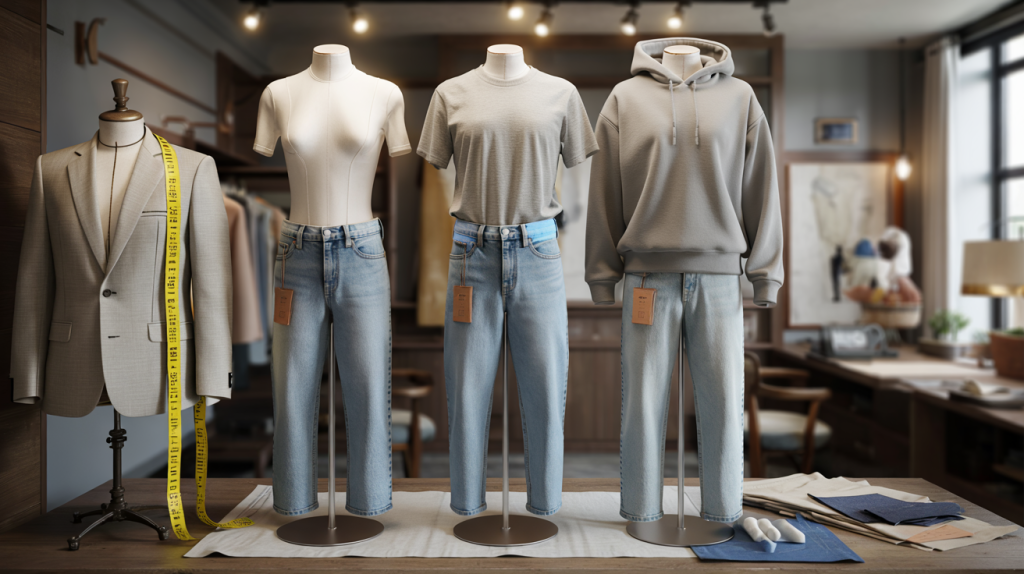Clicking on a size that usually fits, then opening the parcel to find sleeves too short or a waist too snug, it happens to almost everyone. The truth lands fast : clothing sizes are not universal, and brand labels often tell only part of the story.
Here is the core of it, right away. There is no single, mandatory global standard for sizes. Brands choose their own charts, build garments on different body templates, and target different customer groups. Materials, washing, even factory tolerances can shift a fit by crucial centimeters. That is why a medium here is not the same as a medium there.
Why there is no single clothing size standard
Standards exist, they are just not compulsory. ISO 8559-2 : 2017 defines how to measure bodies for apparel. Europe has EN 13402 for size designation. In the United States, ASTM D5585 provides body measurement tables for womenswear. These frameworks offer guidance, not law, so brands stay free to interpret and adapt.
When a label designs its line, it starts from a size block. That block is built on a “fit model”, a real person with specific proportions. Two brands, two different models, two different blocks. The result : different grading rules as sizes go up or down, and different ease values for chest, seat, rise or thigh.
Data has evolved, and so have fits. The SizeUSA study scanned more than 10,000 Americans in 2002 to 2003 using 3D body scanners. It revealed population shifts compared with mid century tables, and many brands updated their blocks from there. Not all did it at the same pace.
Inside a brand’s choices : target customer and vanity sizing
Every collection sets a target. One label might dress endurance runners, another focuses on curvier silhouettes, a third goes for a relaxed street fit. Each of those decisions moves measurements in specific areas, for comfort or style. It is deliberate, not random.
Vanity sizing also plays a part. Over decades, some retailers relaxed measurements so customers fit into a smaller number on the tag. A 1970s size may map closer to a modern size or two down, depending on the category, which feeds confusion between stores.
The stakes online are real. McKinsey’s State of Fashion 2023 reported apparel return rates around 25 to 40 percent in e commerce, with size and fit cited as a leading cause. That is why detailed size charts, fit notes and model measurements have become standard on product pages.
Fabric, construction and tolerances that change the fit
Materials breathe, stretch and shrink. Cotton can shrink about 2 to 5 percent after the first washes, according to Cotton Incorporated, while elastane blends recover differently after wear. A rigid twill hugs unlike a drapey viscose, even when the flat measurements match.
Patterns add ease for movement. A tailored blazer might add minimal ease in the chest for a sharp line. A casual hoodie adds generous ease for layering. Two garments labeled the same size, same wearer, totally different sensations.
Now the factory stage. Every tech pack sets tolerances. A chest spec of 100 centimeters may allow plus or minus one centimeter on the line. Across multiple pattern pieces and fabric lots, small shifts add up. It has been enough to make one tee feel roomy and the next feel tight, even within one brand.
How to shop smarter across brands, without guessing
The goal is not to memorize conversions. It is to switch from the tag to the data the brand gives, and to compare like for like. Here is a simple playbook that helps, definitly.
- Check the size chart against your own recent measurements, not an old memory. Measure bust, waist, hip and inseam close to the body.
- Scan the garment measurements if available, such as shoulder, chest flat, rise and leg opening, then compare with a similar item you own that fits well.
- Read the fabric composition and note shrink risk. Expect cotton rich items to tighten slightly after the first wash, unless pre shrunk is stated.
- Look for fit notes such as slim, regular or relaxed. Treat them as design intent, not marketing filler.
- Use brand fit finders that ask height, weight and preferred fit. When possible, calibrate them by reviewing one past purchase that fit you perfectly.
A quick example helps. Suppose a denim brand lists a 31 waist with a 30 centimeter front rise and 2 percent elastane. Another lists a 31 with a 27 centimeter rise and 0 elastane. Same number, different wear. The first will sit higher, stretch more, and feel looser through the seat after an hour.
There is also the timing question. First wear feels different from the fifth. Knit tees, jeans and sneakers relax during the day, then recover on the hanger. Wovens hold their shape longer, while brushed knits can grow slightly with heat and gravity.
One last piece of context ties it together. Standards such as ISO 8559-2 : 2017 and EN 13402 have created a shared language for measuring bodies and labeling sizes, yet adoption remains voluntary. As brands chase distinct silhouettes and audiences, size variation will persist. The missing link for shoppers is a consistent way to read specs, understand fabric behavior and match those details to personal measurements, which is exactly where the best product pages and sizing tools now lead.
